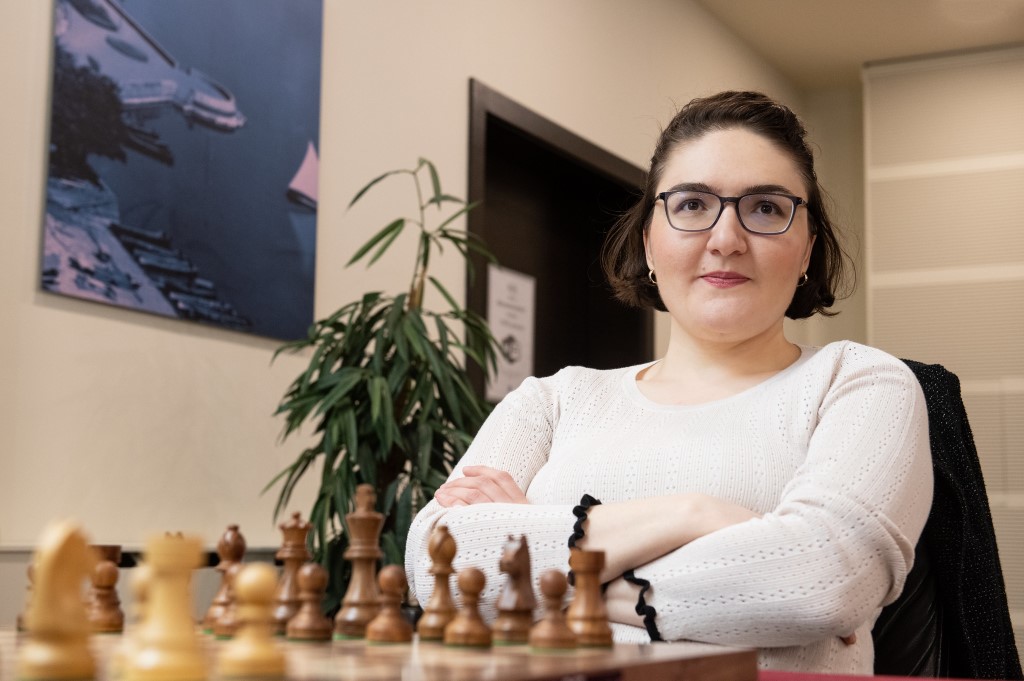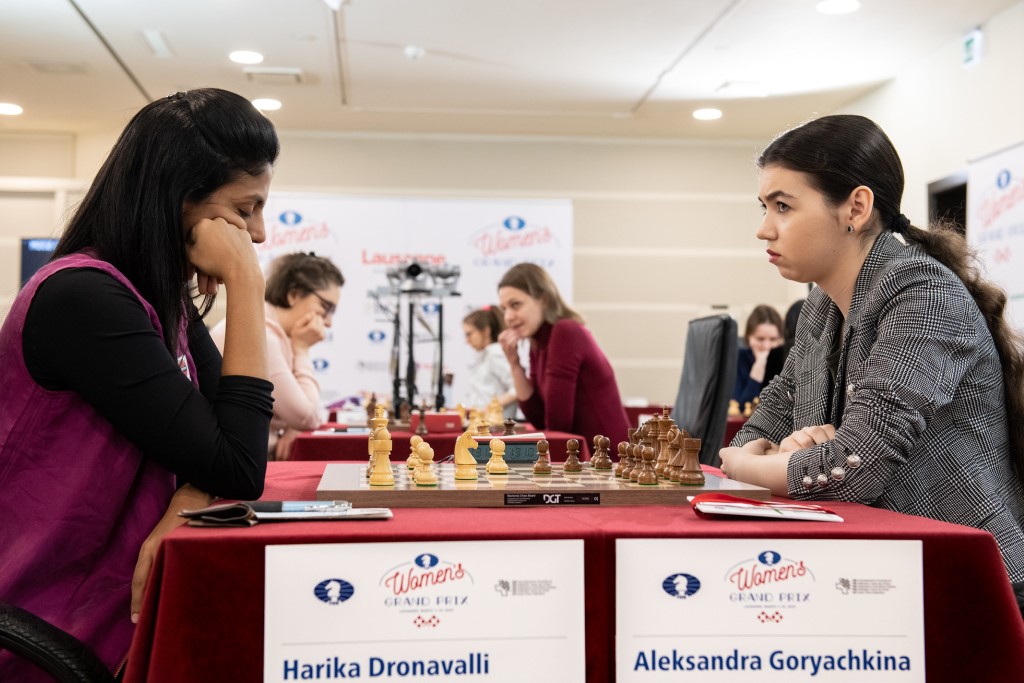Harika and Goryachkina still in the lead
After a not-so-eventful first round, fighting chess has been the rule at the Women's Grand Prix in Lausanne. On Friday, only one game finished decisively, but four of he five draws could have easily ended with one of the players getting a full point. The lengthy eleven-round event will have its only rest day after Saturday's round six, when the participants will most likely feel the strain of having played non-stop since Monday.
The winner of the day was Nana Dzagnidze, who bounced back from her painful loss against Harika Dronavalli the day prior. With that win, Harika had climbed to the shared lead with Aleksandra Goryachkina — the co-leaders were paired up against each other immediately afterwards and signed a relatively quiet draw to keep their standing at the top of the tournament table.

The first move in Pia Cramling v Marie Sebag | Photo: Official site
Dzagnidze's victim was Anna Muzychuk, who went for a closed setup against her rival's Sicilian. Muzychuk got a positional advantage out of the opening, with her queen and pair of knights creating direct threats against the black king. The Ukrainian only gave up her edge when she failed to find a quiet move that would have kept all the trumps she had in the position:
 Dynamic play is what makes your chess effective and most importantly fun! Timur Gareyev shows severeal examples which aspects are important to remember when seizing for the initiative!
Dynamic play is what makes your chess effective and most importantly fun! Timur Gareyev shows severeal examples which aspects are important to remember when seizing for the initiative!
The first move we think of is Muzychuk's 28.exf5, when White is ready to open up the kingside to continue with her attack. However, the quiet 28.♖bc1 was the move that would have kept White's advantage, preventing Black from getting counterplay. After the text, Dzagnidze captured the free pawn with 28...♛xc2 after thinking for over five minutes. A couple more imprecise choices by Muzychuk turned the tables and gave Black the upper hand.
When the time control was reached, Dzagnidze was already completely winning, but Muzychuk decided to test her rival with a final sacrifice:
With Black's three passers on the queenside ready to advance down the board, White realized her only hope was to go all-in with 41.♘xg7. However, after 41...♜xg7 42.♖xg7+ ♛xg7 43.♕xd6 c3 44.♕d5+, Dzagnidze had 44...♛f7 and Muscyhuk resigned — it is true that White can restore material balance with 45.♖xf5 ♛xd5 46.♖xd5, but Black's c-pawn is unstoppable after 46...♜c8.

Nana Dzagnidze during round one | Photo: David Llada
Ju Wenjun faced both Muzychuk sisters in consecutive rounds. While on Thursday she got a slightly inferior — albeit holdable — position against Anna, she found herself in serious trouble the next day against Mariya. The world champion played the Sicilian and bravely fought for the initiative from the get go. At a critical point, Muzychuk gained a second pawn but also gave up an exchange:
 Tired of spending hours and hours on the boring theory of your favourite opening? Then here is your solution, play an Anti-Sicilian with 3.Bb5 against 2...d6 or 2...Nc6, and 3.d3 against 2...e6. In 60 minutes you will get a crash course in how to avoid mainstream theory and in understanding the ideas of this Anti-Sicilian setup. After these 60 minutes you should be able to survive the Sicilian for a long time, without being bothered by new developments found by engine x supported by an x-core machine. Now that it finally comes down to understanding, let's play chess!
Tired of spending hours and hours on the boring theory of your favourite opening? Then here is your solution, play an Anti-Sicilian with 3.Bb5 against 2...d6 or 2...Nc6, and 3.d3 against 2...e6. In 60 minutes you will get a crash course in how to avoid mainstream theory and in understanding the ideas of this Anti-Sicilian setup. After these 60 minutes you should be able to survive the Sicilian for a long time, without being bothered by new developments found by engine x supported by an x-core machine. Now that it finally comes down to understanding, let's play chess!
A tense dynamic balance was maintained with 24.♘xd6 ♝b3 25.♖aa1 ♛b6 (not the most accurate) 26.♕e3 ♝xd1 27.♖xd1 (27.♘e6 was a stronger continuation), but here Ju made a mistake with 27...♛b3, allowing White to consolidate and coordinate her forces. We cannot blame the world champion for having played that imprecision though, as it is visibly hard to deal with a middlegame so filled with possibilities.
Muzychuk was in the driver's seat and, although she missed some chances throughout, she never lost her edge until reaching the endgame, when she miscalculated she could win with three pawns against a sole knight:
White sacrificed the bishop with 63.♗xe4, but Black was in time to stop all the passed pawns — 63...♚xe4 64.g5 ♚e5 65.gxh6 ♚f6 and the king and knight can prevent the pawns from queening. Instead of the text, Muzychuk could have immediately gone for 63.g5, and after 63...e3 (perhaps what the Ukrainian feared) 64.fxe3 hxg5 65.h6 the bishop will guard the h7-pawn and White will slowly infiltrate with the king, winning.

Mariya Muzychuk | Photo: Official site
The main event of the day was not the most exciting of confrontations, as correct play by Harika and Goryachkina led naturally to a 31-move draw. A similar story was seen in the game between Marie Sebag and Pia Cramling, which finished peacefully with a materially balanced queen endgame on the board.
Meanwhile, Zhansaya Abdumalik was a bit too ambitious while facing Alina Kashlinskaya's Petroff, although in the end the latter could not make the most of her chances and had to be careful to keep things under control in the endgame. In the battle between former world champions, Antoaneta Stefanova got some chances against Alexandra Kosteniuk but could inflict the Russian's fourth loss in a row after Kosteniuk held her own under pressure.
Select an entry from the list to switch between games
Standings after Round 5
 The great popularity of the Petroff Defence at the highest level has attracted general attention as strong players employ this opening with great success and with both colours. Unfortunately, the opinion of the Petroff as a sterile drawish opening seems to be firmly implanted in many minds. The author tries to dispel these myths and examines the most popular lines and provides a large number of ideas that will enable you to play Petroff successfully, with either colour.
The great popularity of the Petroff Defence at the highest level has attracted general attention as strong players employ this opening with great success and with both colours. Unfortunately, the opinion of the Petroff as a sterile drawish opening seems to be firmly implanted in many minds. The author tries to dispel these myths and examines the most popular lines and provides a large number of ideas that will enable you to play Petroff successfully, with either colour.
All games
Links


























